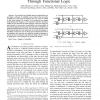Free Online Productivity Tools
i2Speak
i2Symbol
i2OCR
iTex2Img
iWeb2Print
iWeb2Shot
i2Type
iPdf2Split
iPdf2Merge
i2Bopomofo
i2Arabic
i2Style
i2Image
i2PDF
iLatex2Rtf
Sci2ools
TCAD
1998
1998
Test-point insertion: scan paths through functional logic
—Conventional scan design imposes considerable area and delay overheads. To establish a scan chain in the test mode, multiplexers at the inputs of flip-flops and scan wires are added to the actual design. We propose a low-overhead scan design methodology that employs a new test-point insertion technique. Unlike the conventional test-point insertion, where test points are used directly to increase the controllability and observability of the selected signals, the test points are used here to establish scan paths through the functional logic. The proposed technique reuses the functional logic for scan operations; as a result, the design-fortestability overhead on area or timing can be minimized. We show an algorithm that uses the new test-point insertion technique to reduce the area overhead for the full-scan design. We also discuss its application to the timing-driven partial-scan design.
| Added | 23 Dec 2010 |
| Updated | 23 Dec 2010 |
| Type | Journal |
| Year | 1998 |
| Where | TCAD |
| Authors | Chih-Chang Lin, Malgorzata Marek-Sadowska, Kwang-Ting Cheng, Mike Tien-Chien Lee |
Comments (0)

